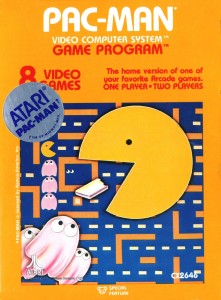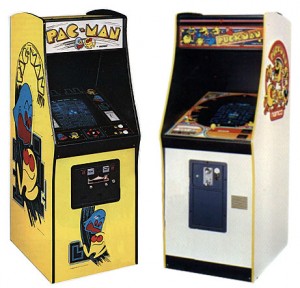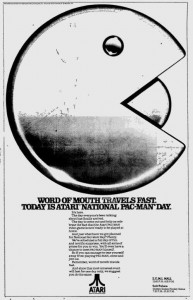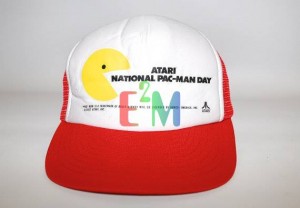 More myths have sprung up behind the development of Tod Frye’s version of Pac-Man for the 2600 than probably any other game Atari released save Howard Scott Warshaw’s E.T. Everything from two versions existing to an extremely limited development time, and even claims of Atari changing the descriptive of Pac-Man’s foes to “ghosts.” So, we decided to get to the bottom of it all and go directly to Tod Frye himself to answer these questions.
More myths have sprung up behind the development of Tod Frye’s version of Pac-Man for the 2600 than probably any other game Atari released save Howard Scott Warshaw’s E.T. Everything from two versions existing to an extremely limited development time, and even claims of Atari changing the descriptive of Pac-Man’s foes to “ghosts.” So, we decided to get to the bottom of it all and go directly to Tod Frye himself to answer these questions.
First, lets understand the context of this project and place in time. It was 1981 and Atari had the license for home versions of one of the hottest arcade titles, NAMCO’s Pac-Man. It was to be the flagship of a new generation of games that were testing the skills of 2600 programmers to make the console dance like it never had before. How so? The 2600’s hardware was designed back when arcade game graphics were simple sprites (or “stamps” as they were called in Atari’s Coin group), and simple shapes like a tank, paddle or car. There were no complex backgrounds (playfields) to speak of either. The 2600’s purpose was to bring those sorts of mid 70s games into the home.
Around 1979 though, the arcade game landscape started to change drastically as microprocessor driven arcade games with more and more RAM for graphics work started using bitmapped based graphics to a greater degree than ever before. The concept of bitmaps is simple: A block of the video screen at any given moment is represented in a block of RAM composed of a bunch of zeros and ones representing the screen’s pixels. Turn a bit on and the pixel shows up rendered on the screen. Leave it at zero and nothing is there. Many games used the concept for defining and rendering individual sprites and background elements as well. Even the 2600 used a related concept by building out all the pixels on a screen on scan line by scan line basis, though it did this on the fly and separated the background and player sprites internally in its hardware.
What happened in the late 70s then was that as larger amounts of RAM were used (along with other advancing support hardware) the coin developers were able to represent an entire screen (called a frame) at once, so that as that frame was being drawn they could pre-render the next one and so on. All the characters, backgrounds, etc. could now be layered out like a painting and then thrown on the video screen. Though keep in mind because it’s still a computerized game it’s not quite as freeform as a painting, and placements of individual elements need to be calculated. So, the idea of a grid and what became known as “tile” or “character” graphics were commonly used. Each element that makes up a screen was pre-mapped in dimensions and laid into the screen as needed similar to how tiles are laid across a floor. Background related tiles tended to have little if any motion, while foreground tiles (like the player and its enemies) move pixel by pixel across this hidden grid.
 In the case of Pac-Man it’s a 28 x 36 grid of these tiles, each tile consisting of one block of 8 x 8 pixels. Need a maze corner at a certain location? The code simply references the pre-mapped graphic element stored in the game’s ROM, which the system grabs and throws into place when rendering the screen. Even more advanced, the hardware these games like Pac-Man were using allowed multiple colors in these tiles. Multi-colored detailed sprites and tile based graphics were just not something the 2600 was designed to do. But now these developers at Atari were being asked to create home versions of these very same bitmapped games on that unrelated hardware with far less resources.
In the case of Pac-Man it’s a 28 x 36 grid of these tiles, each tile consisting of one block of 8 x 8 pixels. Need a maze corner at a certain location? The code simply references the pre-mapped graphic element stored in the game’s ROM, which the system grabs and throws into place when rendering the screen. Even more advanced, the hardware these games like Pac-Man were using allowed multiple colors in these tiles. Multi-colored detailed sprites and tile based graphics were just not something the 2600 was designed to do. But now these developers at Atari were being asked to create home versions of these very same bitmapped games on that unrelated hardware with far less resources.
And just to make it more challenging with Pac-Man, Tod felt it had to be a two player version as well. That meant the 128 bytes of memory (that’s bytes, not K) had to also keep track of two full mazes. So make the hardware do what it wasn’t designed for, with less resources than normal available, and do it under the already demanding schedule of a commercial product deadline.
 How did it fall into Tod Frye’s lap? Simple, he chose it. Console game projects at that time were posted to a bulletin board in the Consumer Division developers area nicknamed “The Zoo.” Tod had been at Atari Inc. since late 1979, when he completed a version of Breakout for the soon to be cancelled LCD handheld series Atari was working on. (According to Tod it never shipped because manufacturing costs were too high). In 1980 through early ’81 he completed Asteroids for the 400/800 PCS. After spending some time getting acquainted with the 2600s hardware, Pac-Man was to be his first project for the 2600. After inspecting the available projects, the two newest being Defender and Pac-Man, he chose Pac-Man after discovering developer Bob Polaro had already been on Defender. The specs were challenging of course. Not only because it was a more advanced game than the 2600 was originally intended to play, but because Tod felt the project had to use the limited resources to also make this a two player game. (As Tod stated, “I just assumed it had to be a 2 player game, like the arcade. Also, i felt (and still feel) that the inclusion of a 2 player mode gave a better value to the customer, as sometimes playing 2 player is FUN!”). Now Tod had already been put on probation by his boss Dennis Koble, so he knew he was under a magnifying glass. Add to that the complexness of making the game on the 2600 hardware in even the normal project deadline and you have a strong sense of urgency building in Tod’s mind. He did it though and on time, starting in May ’81 and finishing the second week of September.
How did it fall into Tod Frye’s lap? Simple, he chose it. Console game projects at that time were posted to a bulletin board in the Consumer Division developers area nicknamed “The Zoo.” Tod had been at Atari Inc. since late 1979, when he completed a version of Breakout for the soon to be cancelled LCD handheld series Atari was working on. (According to Tod it never shipped because manufacturing costs were too high). In 1980 through early ’81 he completed Asteroids for the 400/800 PCS. After spending some time getting acquainted with the 2600s hardware, Pac-Man was to be his first project for the 2600. After inspecting the available projects, the two newest being Defender and Pac-Man, he chose Pac-Man after discovering developer Bob Polaro had already been on Defender. The specs were challenging of course. Not only because it was a more advanced game than the 2600 was originally intended to play, but because Tod felt the project had to use the limited resources to also make this a two player game. (As Tod stated, “I just assumed it had to be a 2 player game, like the arcade. Also, i felt (and still feel) that the inclusion of a 2 player mode gave a better value to the customer, as sometimes playing 2 player is FUN!”). Now Tod had already been put on probation by his boss Dennis Koble, so he knew he was under a magnifying glass. Add to that the complexness of making the game on the 2600 hardware in even the normal project deadline and you have a strong sense of urgency building in Tod’s mind. He did it though and on time, starting in May ’81 and finishing the second week of September.
As Tod explained to us about some of his development and design decisions on the Pac-Man project, “We were still new at doing advanced arcade ports to the VCS . There was Space Invaders and Asteroids; both of those used their own color schemes and Asteroids looked and played different from the arcade. I wanted to add more color to the maze instead of black and blue, so I chose the colors. The maze was also very difficult to implement, so the exits were placed on the tops and bottoms instead of the sides. My primary focus was on the game play and making sure the game mechanics of the arcade were in the VCS title as close as could be done.”
Anticipation for Pac-Man’s pending release in 1982 was built up thanks to a big PR blitz from Atari. After all, this was the hottest arcade game to appear on a console since Atari had release their home version of Space Invaders in 1980. The game that had single handedly driven demand for the 2600 and drastically opened up the demand for new games for the console over the previous year. Marketing even planned on having the title replace the reliable Combat cartridge as the pack-in game for the 2600, assuming it would drive 2600 console sales even further into the stratosphere than they already were.

They planned a National Pac-Man Day blitz in the U.S. for early April ’82 as the official launch time for the game, something that had never been done before in the market. Stores would have lots of Pac-Man day swag to give away to pump up the fervor, and selected locations would even have Pac-Man himself there to take pictures with the kids and sign autographs. The sought after local co-ordination never happened however due to the already strong demand of the title. As stock started coming into some stores in early March of 1982, they began putting out the title and even advertising its availability.

It was over the next several months that the game became the iconic contradiction that history sees it as. Sales of the game skyrocketed, eventually making it the highest selling 2600 game of all time. Yet the fact that it visually looked very dissimilar to the arcade game they had loved also troubled gamers. Granted they were happy to be playing any version at home at the time and fully expected their home versions to be more similar to the arcade ones than exact replicas. But this version just looked so different. As the third party industry exploded that summer and consumers began being deluged with more and more games fighting for a place in their homes, Atari had an issue. For the first time its name was no longer an assured seal of quality. Pac-Man made people cautious about seeing games with the Atari name on them as an automatic good purchase. While it did little to single handedly hurt Atari in any major way, the timing of the factors it came to represent (at a time when Atari’s overall internal issues were coming to a head that summer) have placed it in the annals of history as a symbol for the beginning of the end of Atari Inc.
Along with any good icon comes a slew of myths over time to explain how what happened, happened. Hence the purpose of this article. Now on with some of the myths and the presentation of the real facts…
Bob Polaro passed on the project saying it couldn’t be done
The myth was that Bob had originally been asked to do Pac-Man, but turned it down because he felt it couldn’t be done in the limited resources available for the game so he took Defender instead. This turns out not to be the case, as according to Bob:
“The reason why I chose defender over Pac-Man was because I had been asked previously to design Defender, started the design, then asked if I would switch to Pac-Man. Since I always try to finish what I start, I chose to continue with Defender. It had nothing to do with technical requirements.”
On claims of a 4K and 8K version existing and a rushed timeline.
Marty: Were you offered to move to 8K for Pac-Man towards the end of coding for it? Howard claimed that but I hadn’t heard that before.
Tod: Nope. 8k wasn’t even an option until after Pac-Man coding was complete. I did have a meeting after Pac-Man came out, to assess the possibility of a quick revision with less flicker, if we used 8k as an option.
Marty: So where did the claim that you originally asked for 8K come from? Can you tell me a little more about that meeting? Obviously the outcome was not to revisit it at 8K.
Tod: It came from thin air. I never considered 8k. ROM was not really an issue, RAM was. I have a sprite reuse kernel, that would use re-position players as the screen went down. The scheduler that would minimize flicker was under consideration, would have needed some ram, and was a very tricky algorithm. Eventually I jettisoned the idea in order to get done sooner.
Marty: You had mentioned to me previously you had the full normal dev time. As far as the rushing do you mean the pressure to get it done under the normal product deadline you mentioned you had?
Tod: Actually, Pac-Man was done a little quickly. Not quite normal deadline. But it was a lot of work, and at times i had to stretch to get it done in a reasonable amount of time. So, while I had a tech POC for reusing sprites, i did not have a clear design for a sprite scheduler that would adapt to the position of the sprites and distribute distribute display availability fairly.
Marty: What was the reason for the slightly accelerated deadline?
Tod: That it’s a complicated algorithm to implement with minimal RAM and ROM. My own sense of urgency.
That Tod Frye held out the finished game for more money
The myth goes that “Tod waited until he was 2/3rds of the way done with the Pacman coding and then marched into Ray Kassar’s office and demanded a 10 cent per cartridge royalty. Knowing that nobody else would be able to pick up the code and finish it in time, or rewrite from scratch and still make Christmas, he capitulated and Tod got Atari’s first ever royalty.”
The truth was it was Tod’s first game after joining Atari, and he wasn’t in any sort of position to have clout like that. Tod was already on probation per his annual review by Dennis Knoble, so he made sure to put in a lot of extra hours and effort on Pac-Man. He started in May ’81 and finally finished the second week of September. It was after Pac-Man was done that Tod and a few others planned to go as a group to let Atari know they were planning on leaving to do 2600 games elsewhere (20th Century Fox had approached them about doing games). Tod spilled it to George Kiss who in turn let Ray Kassar know. Two days later there was a general meeting called with everyone and people were handed bonus checks, and the royalty program started right after that.
As Tod confirmed:
“Pac-Man was done, wrapped, sent off for ROM mask long before the compensation was adjusted at Atari. The story that I extorted Ray has a certain cachet, but is completely bogus. I mean look, if i had the business chops to extort management for a percentage, I would have gone a lot higher that $0.10 per cart. The margin was like $25, so i would have gone for at least $1.00… more likely $2.50. Then I would have bought MicroSoft, and really rocked for 25 yrs.”
On the “head of marketing” urging Ray Kassar not to release it
There’s multiple versions of this claim, usually focusing on the “head of marketing” telling Kassar that nobody will want to play the game and it shouldn’t be released, giving the impression that Atari’s own marketing group had lost faith in the very product it was supposed to be championing. There’s a problem with that narrative though. It turns out the person who talked to Ray was Frank Ballouz, head of the Coin Division’s marketing department. He of course had nothing to do with the Consumer Division, and had made the comment after seeing a demonstration of the game.
Marty: Supposedly after seeing the 2600’s soon to be released home port of Pac-Man you stated to Ray Kassar that nobody would want to play it, but you were ignored. Is that actually what happened?
Frank: Basically, yes…I think my evaluation may have been a little stronger…as many things with Ray he knew better…sort of like ET…the rest is history!!
On Atari purposely overproducing Pac-Man cartridges
Another prevailing myth is that Atari sought to overproduce the game from the beginning, producing more games than there were consoles. The book Racing The Beam even goes so far as to call it an “irresponsibly large production run of more than 10 million.” Here’s the problems with that though given the facts:
The production number was based on two factors: the projected number of 2600s on the market by the end of the year, and the additional amount needed as the game assumed its role as the new pack-in game for the 2600.
According to even the press coverage of the time, 2600 sales actually surpassed their goals and hit about 12 million units in homes by the end of the Christmas ’82 season. Between that and the pack-in needs, the production amount actually turns out be a very conservative one.
Atari was responsible for changing the antagonists from “monsters” to “ghosts”
While certainly Atari was certainly responsible for helping to popularize the concept of Inky, Blinky, Pinky and Clyde as being ghosts, they were not the first to begin calling them that. Some point to the fact that monsters is what appeared on the bezel instruction cards for Pac-Man and Ms. Pac-Man, and Atari was the first in public calling them ghosts. There’s a problem with that though.
First, Ms. Pac-Man was released in February 1982 as Keith Smith (http://allincolorforaquarter.blogspot.com/) confirmed:
Ms. Pac-Man was released around February, 1982. The DRA Price Guide, RePlay catalog, and Play Meter catalog all give a release date of February, 1982. Its release was announced in the 2/82 RePlay, the 2/82 Vending Times, and the 3/15/82 Play Meter. The trademark database shows a first use in commerce of 1/13/82 and a first use anywhere of 1/8/82. It was not shown at the 1981 AMOA. It might have been shown at the ATE in January, 1982, but I don’t know.
Why is this important? Because while it wasn’t on the bezel instructions, the manual (from January 1982) and flyer (also from then) for Ms. Pac-Man both use the term “ghosts.”
http://www.arcade-museum.com/manuals-videogames/M/MsPac-Man.pdf
http://flyers.arcade-museum.com/?page=flyer&db=videodb&id=707&image=2
Also consider the fact that ghosts and monsters don’t have as much of a difference in Japan as they do in Western context:
http://hyakumonogatari.com/2013/11/15/whats-the-difference-between-yurei-and-yokai/
Finally we have Pac-Man creator Tōru Iwatani, who also refers to them as ghosts and “ghost shaped monsters” and explains he had ghosts in mind when creating the four of them:
https://programmersatwork.wordpress.com/toru-iwatani-1986-pacman-designer/
“Pac-Man is inspired by all the manga and animation that I’d watch as a kid. The ghosts were inspired by Casper, or Obake no Q-Taro.” – from http://www.wired.com/2010/05/pac-man-30-years/
“Some of the elements are related to ghosts. The way the ghosts were designed, it’s not something nasty. It’s an enemy, but still somewhat amicable, lovable. ” – from http://pacmanmuseum.com/history/Toru-Pac-ManCreatorSpeaks.php
‘Yes. The relationship between PAC-MAN and the Ghosts is like Tom and Jerry’s “Fight in a friendly way . . . ” PAC-MAN does not eat until he dies. It’s just a fight over the cookies, something like “Don’t eat my cookies.”‘ – from http://www.onlinespiele-sammlung.de/pacman/interview2.html
Tod’s Regrets
“If i have one regret (and i have many), it is the color scheme. i truly wish i had gone for the blue maze on the black background. IIRC (and perhaps i’d – likely more so than anyone else possibly can) i was influenced by the color scheme Space Invaders used, where the ‘variations’ used color schemes different from the arcade version.”
Conclusion
Hopefully this clears up the most prevalent myths behind this game. A game that Tod’s fellow developers at Atari said they had nothing but respect for what he was able to accomplish back then when we interviewed them for our book. We’ll be sure to update this article though as more myths and facts are uncovered, so be sure and check back!

